- Like
- SHARE
- Digg
- Del
- Tumblr
- VKontakte
- Flattr
- Buffer
- Love This
- Save
- Odnoklassniki
- Meneame
- Blogger
- Amazon
- Yahoo Mail
- Gmail
- AOL
- Newsvine
- HackerNews
- Evernote
- MySpace
- Mail.ru
- Viadeo
- Line
- Comments
- Yummly
- SMS
- Viber
- Telegram
- JOIN
- Skype
- Facebook Messenger
- Kakao
- LiveJournal
- Yammer
- Edgar
- Fintel
- Mix
- Instapaper
- Copy Link
 Joint Health
Joint Health
In a society that has never needed to exercise more and eat less, we find ourselves with a dilemma: If you are overweight, or live a sedentary lifestyle; yet you are plagued with joint-related pain, then the option to exercise – to lose the extra weight – becomes a daunting task. And yet, it’s the weight and accumulated wear-and-tear that is partially causing the pain in the joints – so what do you do?
Conversely, if you are a high-level athlete, competitive crossfitter or workout enthusiast and become injured (say, a torn labrum, or degenerated rotator cuff with subsequent synovial fluid distress and bony cyst formation with nerve impingement) – how do you return to the top of your game?
You’re not alone and there are things you can do to return to greatness. But first you should know a little more about your joints. It will give you a better appreciation for all they do for you.
Osteoarthritis: What is it?
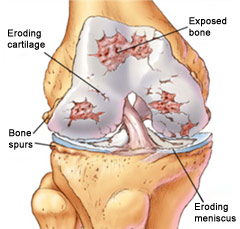 What we are talking about here is osteoarthritis (OA), an affliction to the joints of the human body that causes pain and inflammation. Osteoarthritis also goes by DJD, or degenerative joint disease. It occurs as a result of a deterioration of the articular cartilage (the material that coats the ends of our articulating bones), resultant osteophyte (bone-forming cells) formation and subsequent osseous remodeling as well as changes to the surrounding (periarticular) tissues such as the surrounding collagen tissues of our joints as well as the ligamentous tissues which connect to our bones and muscles.
What we are talking about here is osteoarthritis (OA), an affliction to the joints of the human body that causes pain and inflammation. Osteoarthritis also goes by DJD, or degenerative joint disease. It occurs as a result of a deterioration of the articular cartilage (the material that coats the ends of our articulating bones), resultant osteophyte (bone-forming cells) formation and subsequent osseous remodeling as well as changes to the surrounding (periarticular) tissues such as the surrounding collagen tissues of our joints as well as the ligamentous tissues which connect to our bones and muscles.
Analogy: Think of your joints as a freshly paved highway. Now add road traffic, changing seasons and surrounding nature as your natural wear and tear. Cracks begin to form, then potholes. Then, before you know it, the potholes increase in size and require maintenance.
Our bodies operate in a similar fashion: once we wear down the cartilage surfaces of our joints, we expose the next layer of tissue – bone. Our bodies have a very poor reparative process on their own to regenerate cartilage, but the human body has no issues with laying down more bone.
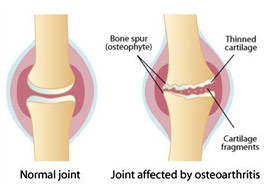 In fact, our bodies are so good at laying down more bone, it is the equivalent of the roadwork guys in the summer laying down shovelfuls of asphalt without using the steam roller to ensure a perfect seal. Before you know it, the first few cars have torn up the freshly laid material, and you have to patch up the hole the following season. Our bodies do this, which is why OA is an advancing process that worsens as we age and neglect adequate care.
In fact, our bodies are so good at laying down more bone, it is the equivalent of the roadwork guys in the summer laying down shovelfuls of asphalt without using the steam roller to ensure a perfect seal. Before you know it, the first few cars have torn up the freshly laid material, and you have to patch up the hole the following season. Our bodies do this, which is why OA is an advancing process that worsens as we age and neglect adequate care.
To date, there is no known cure to combat OA. However, all treatment options focus on pain management, improving joint function and slowing down the degenerative process within the joints themselves. Therapies include weight management, controlled exercise (to preserve the joints), as well as anti-inflammatory medications. Nutritional supplements are also used to combat the inflammatory mediators, promote chondrocyte (cartilage-forming cells) health and repair and reduce oxidative damage to the affected tissues.
THE KEY THREE
 There are several things you can do to combat the effects of advancing OA, as listed below.
There are several things you can do to combat the effects of advancing OA, as listed below.
1. Rest
There is nothing you can do better than to take time off. Especially if you are fighting a lingering injury, or one that is getting worse despite a reduced workout regimen. Failure to do this will cause you to build up further muscle, ligament and tendonous inflammation with resultant micro-tears, then scar tissue build up and non-uniform healing of said tissues. These are usually the athletes who are so hard on their bodies that surgery is often required. There is nothing wrong with cross-training other areas of your body while allowing for recovery of the affected ones. Train smart, not hard.
2. Rehab
The wizened athlete will listen to their bodies and know something is wrong – and do something about it. Chiropractors help with balancing out structures issues, physical therapists and corrective exercise therapists help balance out functional issues, and manual therapists help out with lower-level injuries (tight / chronically sore muscles). Knowing where you are in terms of injury will allow you to link up with the appropriate health care practitioner. ALWAYS have a health care team in your corner.
3. Rx
I am not a huge fan of prescription or OTC medications such as Aleve, other NSAIDS or ibuprofens. They give the user a false sense of invulnerability, much the same as cutting the wires to a fire alarm with the building still smoldering. Sure, you don’t hear the noise, but the structure is still dysfunctional. So, what do I recommend – the CORE FOUR.
THE CORE FOUR
We have discussed that in order to reduce your chances of developing advanced OA, you need to be smart and listen to your body.
But what about what you put into your body?
Supplementation is key here, because we often are over-fed and undernourished. Further, when recovering from exercise or injury, we place increased cellular demands on bodies to do some extra work. Further, for our bodies to begin initiating cellular repair of highly-specialized tissues like collagen and cartilage, we would need to eat in abundance select foods, which nearly all of us don’t even have the time for.
So, what should I be taking?
Well, for one – let’s back up a bit and recap. This is important. All of our joints require synovial fluid and articulating cartilage-based surfaces for optimal function. Cartilage cushions the joint as it is softer than bone and the synovial fluid exists to lubricate the surfaces and minimize degradation.
Through high-intensity-interval training; repetitive, high-impact movements; and routine training with minimal rest, you begin to degrade the cartilage, reduce your body’s ability to manufacture synovial fluid and promote bony growth into the key areas. Pain and inflammation, as well as reduced range of motion and joint stiffness are the result because the individual has exceeded the maximal rate at which the body can keep up with the rate of repair.
That said, here are my top 5 supplement recommendations for healthy joints:
1. Fish Oil
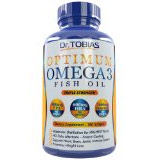 We have discussed that there are inflammatory processes that occur during OA. The body has pain-pathways with as many enzymatic reactions: those that promote pain signaling, and those that reduce its effects – hence an anti-inflammatory agent. Along the COX-1 and COX-2 pathways, there are inflammatory agents such as PGE2, IL-1, IL-2 and TNF. Having fish oils in your diet will aid by suppressing the effects of these inflammatory agents and, at the chemical level, reduce the intensity of pain signaling and subsequent joint-pain reduction.
We have discussed that there are inflammatory processes that occur during OA. The body has pain-pathways with as many enzymatic reactions: those that promote pain signaling, and those that reduce its effects – hence an anti-inflammatory agent. Along the COX-1 and COX-2 pathways, there are inflammatory agents such as PGE2, IL-1, IL-2 and TNF. Having fish oils in your diet will aid by suppressing the effects of these inflammatory agents and, at the chemical level, reduce the intensity of pain signaling and subsequent joint-pain reduction.
Further, taking fish oils regularly helps throughout your body by knocking down inflammation so other cell processes within the body can begin to tissue soft repair. This is also linked to why taking fish oils helps reduce joint stiffness and soreness, as well as promote range of motion.
2. Glucosamine
 Many of us have heard of this product. It is traditionally found in conjunction with chondroitin. Glucosamine is an amino-sugar, and is a main constituent in glycosaminoglycan, a key substance that comprises the connective tissue matrix. Glucosamine is a building block of chrondroitin sulfate. Those with OA, for example, will have a decreased ability to synthesize glucosamine by the chondrocytes (cartilage-rebuilding cells). Those who supplement with this product will cause a stimulatory effect on the chondrocytes, which will help repair the collagen and connective tissue matrix.
Many of us have heard of this product. It is traditionally found in conjunction with chondroitin. Glucosamine is an amino-sugar, and is a main constituent in glycosaminoglycan, a key substance that comprises the connective tissue matrix. Glucosamine is a building block of chrondroitin sulfate. Those with OA, for example, will have a decreased ability to synthesize glucosamine by the chondrocytes (cartilage-rebuilding cells). Those who supplement with this product will cause a stimulatory effect on the chondrocytes, which will help repair the collagen and connective tissue matrix.
3. Chondroitin
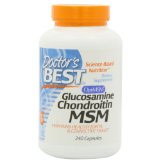 This product, like glucosamine, naturally occurs and is synthesized by the body. It is synthesized by the chondrocytes. So, we need glucosamine to create chondroitin sulfate, and we need this to be synthesized by the chondrocytes. This substance is an important integral component found within cartilage and essential to preserving healthy cartilage. Glucosamine and Chondroitin-sulfate have long been studied and their effects combined have shown reduced pain symptoms for those who have OA. The research is mixed about its role in preventative care; however, longitudinal studies are still on-going.
This product, like glucosamine, naturally occurs and is synthesized by the body. It is synthesized by the chondrocytes. So, we need glucosamine to create chondroitin sulfate, and we need this to be synthesized by the chondrocytes. This substance is an important integral component found within cartilage and essential to preserving healthy cartilage. Glucosamine and Chondroitin-sulfate have long been studied and their effects combined have shown reduced pain symptoms for those who have OA. The research is mixed about its role in preventative care; however, longitudinal studies are still on-going.
4. Methylsulfonylmethane (MSM)
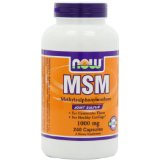 This compound has found favor within the OA community due to its sulfur-containing bond. In the body, sulfur is necessary to strengthen structural bonds, such as those found within the collagen matrix. This bond helps to offset structural degradation, which is why you can find hair care products with sulfur bonds in them. Think of this ingredient as having a necessary supporting role.
This compound has found favor within the OA community due to its sulfur-containing bond. In the body, sulfur is necessary to strengthen structural bonds, such as those found within the collagen matrix. This bond helps to offset structural degradation, which is why you can find hair care products with sulfur bonds in them. Think of this ingredient as having a necessary supporting role.
5. BONUS – Hyaluronic Acid
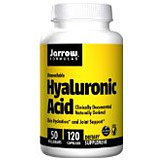 This compound is integral as it is part of the extracellular matrix. It is synthesized within the chondrocytes as well as the synovial fluid (synoviocyte cells in the joint lining) and is a part of the protein family glucosaminoglycan. Due to it being found within extracellular matrix as well as synovial fluid, it has compression-resistant qualities, so it acts as a natural buffer during joint compression.
This compound is integral as it is part of the extracellular matrix. It is synthesized within the chondrocytes as well as the synovial fluid (synoviocyte cells in the joint lining) and is a part of the protein family glucosaminoglycan. Due to it being found within extracellular matrix as well as synovial fluid, it has compression-resistant qualities, so it acts as a natural buffer during joint compression.
While some supplement companies add Hyaluronic acid to their compounds, due to the interrelated synthesis pathways of glucosamine and chrondroitin-sulfate, the body can create hyaluronic acid, so the synthetic form is purely icing on the cake.
The Bottom Line
One must not discount the role of oxidative stress and its role on inflammation. Many supplement companies will often add Vitamin C for collagen formation / anti-oxidant properties; and Manganese, Copper and Zinc for collagen/glucaminoglycan synthesis. So if you see these on the label, it’s a better-produced product.
Many companies promote products with ratios of 1,000 – 1,500mg / day. The research supports that this is a healthy amount to be utilized and absorbed effectively by the body. For those under 100 pounds, 1,000mg of glucosamine and 800mg of chrondroitin sulfate are recommended. For those 100+ pounds, 1,500mg and 1,000mg are recommended, respectively.
Have you tried any of these supplements for joint pain? What was your experience? Let us know in the comments below!
References:
1. Ferrucci, L. et. al, 2006. Relationship of plasma polyunsaturated fatty acids to circulating inflammatory markers. J Clin Endocrinol Metab. 91(2): 439 – 446.
2. Gray, L. 2014. Joint Supplements: What’s hip and what’s hype. Retrieved from: https://www.smartpakequine.com/content/horse-joint-supplement-ingredients
3. Spine-Health. 2014: Safe use of glucosamine and chrondroitin sulfate supplements. Retrieved from: http://www.spine-health.com/conditions/arthritis/safe-use-glucosamine-and-chondroitin-sulfate-supplements
4. Uebelhart, D., Thonar, E.J., Delmas, P.D., Chartraine, A. & Vignon, E. 1998. Effects of oral chondroitin sulfate on the progression of knee osteoarthritis: a pilot study. Osteo Cartilage. 6S: 39-46.
5. Zerkak, D. & Dougados, M. 2004. The use of glucosamine therapy in osteoarthritis. Curr Rheumatol Rep. 6(1): 41 – 45.
About Erik Uuksulainen
True North Chiropractic Erik Uuksulainen is a board certified doctor of chiropractic who specializes in working with athletes, both at the recreational as well as collegiate level. Dr. Erik holds a MS in Clinical Nutrition (2010). In 2004, he graduated from the University of Guelph, Canada, with a BSc in Human Kinesiology.


I’ve been taking fish oil and a combination chondroitin/glucosamine supplement for the past few years and it seems to have helped alleviate some of the pain in my knees. Will have to give MSM and hyalronic acid a try.
Thanks for sharing! I personally take all 5 and have noticed a difference myself.